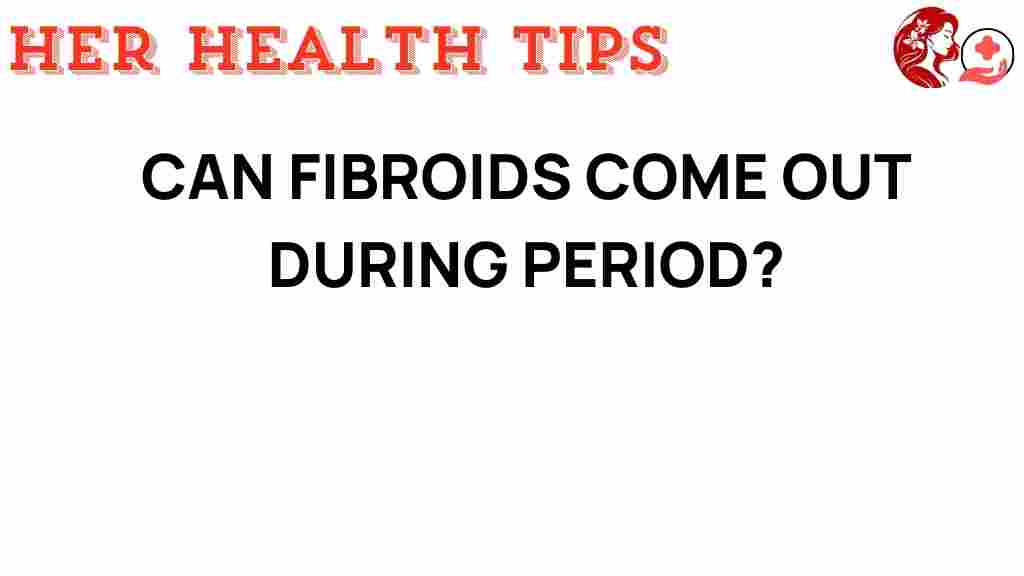Can Fibroids Really Be Passed During Your Period? Discover the Truth
Fibroids are non-cancerous growths that develop in or on the uterus, affecting many women during their reproductive years. Understanding how fibroids impact menstrual health is essential for women seeking to maintain their overall well-being. A common question among women experiencing menstrual disturbances is whether fibroids can be passed during their periods. In this article, we will explore the relationship between fibroids and menstrual health, focusing on symptoms, diagnosis, treatment options, and their implications for women’s reproductive health.
Understanding Fibroids and Menstrual Health
Fibroids, also known as uterine leiomyomas, are comprised of muscle and fibrous tissue. They can vary in size, number, and location within the uterus—making their impact on menstrual health quite diverse. Depending on their size and placement, fibroids can lead to a range of symptoms that can significantly affect a woman’s quality of life.
Common Symptoms of Fibroids
Women with fibroids may experience various symptoms, including:
- Heavy menstrual bleeding: This is one of the most common symptoms associated with fibroids. Women may find that their periods are longer and heavier than normal.
- Pelvic pain or pressure: Depending on their size and location, fibroids can cause discomfort or a feeling of fullness in the pelvic area.
- Frequent urination: Fibroids that press on the bladder may lead to increased urination.
- Back pain: Some women report back pain that can be attributed to the pressure from fibroids.
- Difficulty emptying the bladder: Larger fibroids may obstruct the urinary tract.
It is essential to note that while some women with fibroids experience severe symptoms, others may be asymptomatic. This variability can complicate the diagnosis and treatment process.
Diagnosis of Fibroids
Diagnosing fibroids typically involves the following steps:
- Medical history review: A healthcare provider will review your menstrual history, symptoms, and any relevant family history.
- Pelvic examination: A physical exam may be performed to check for abnormalities in the pelvic region.
- Imaging tests: Ultrasound is the most common imaging test used to visualize fibroids. Other imaging techniques include MRI and hysterosonography.
After diagnosing fibroids, the next step is to discuss the treatment options available.
Treatment Options for Fibroids
Treatment for fibroids depends on various factors, including the size and location of the fibroids, the severity of symptoms, and a woman’s reproductive plans. Here are some common treatment options:
- Medications: Hormonal treatments can help manage symptoms, such as heavy bleeding. Nonsteroidal anti-inflammatory drugs (NSAIDs) may also be recommended for pain relief.
- Minimally invasive procedures: Options like uterine artery embolization (UAE) can shrink fibroids without the need for major surgery.
- Surgical options: In cases where fibroids cause significant problems, procedures such as myomectomy (removal of fibroids) or hysterectomy (removal of the uterus) may be considered.
The Relationship Between Fibroids and Menstrual Periods
Understanding whether fibroids can be passed during your period requires insight into how they interact with the menstrual cycle. During menstruation, the uterus sheds its lining, which can lead some women to wonder if fibroids can also be expelled.
Can Fibroids Be Passed During Your Period?
It is unlikely for fibroids themselves to be passed during a menstrual period. Instead, what some women may experience is the shedding of the uterine lining and blood clots that may resemble fibroids. This can be particularly true for women with larger fibroids, as they might experience more significant clotting during heavy menstrual bleeding.
However, it is crucial to differentiate between actual fibroids and blood clots or tissue. If you notice large clots or have concerns about your menstrual health, it is important to consult a healthcare provider for a thorough evaluation.
Managing Symptoms During Your Period
For women with fibroids, managing symptoms during menstruation is vital for maintaining comfort and quality of life. Here are some strategies:
- Use heat therapy: Applying a heating pad to the abdominal area can help alleviate cramps and discomfort.
- Stay hydrated: Drinking plenty of water can help reduce bloating and discomfort.
- Medication: Over-the-counter pain relievers such as ibuprofen can help manage menstrual pain.
- Track your cycle: Keeping a menstrual diary can help you identify patterns and symptoms, aiding in discussions with your healthcare provider.
When to Seek Medical Help
If you experience any of the following symptoms, it is essential to seek medical attention:
- Severe or debilitating pain during your period
- Heavy bleeding that soaks through a tampon or pad every hour for several hours
- Symptoms of anemia, such as fatigue or dizziness
- Any sudden changes in your menstrual cycle or symptoms
Conclusion
In summary, while fibroids can significantly impact menstrual health and lead to various symptoms, they are not typically passed during periods. Understanding the nature of fibroids and their relationship with the menstrual cycle is crucial for women’s health. If you suspect you have fibroids or are experiencing troubling symptoms, it is essential to consult with a healthcare provider for proper diagnosis and treatment options. By staying informed about your reproductive system and menstrual health, you can take proactive steps toward maintaining your overall well-being.
For more information on fibroids and women’s health, visit this resource. If you’re interested in understanding more about menstrual health, check out this article.
This article is in the category Reproductive and created by HerHealthTips Team
